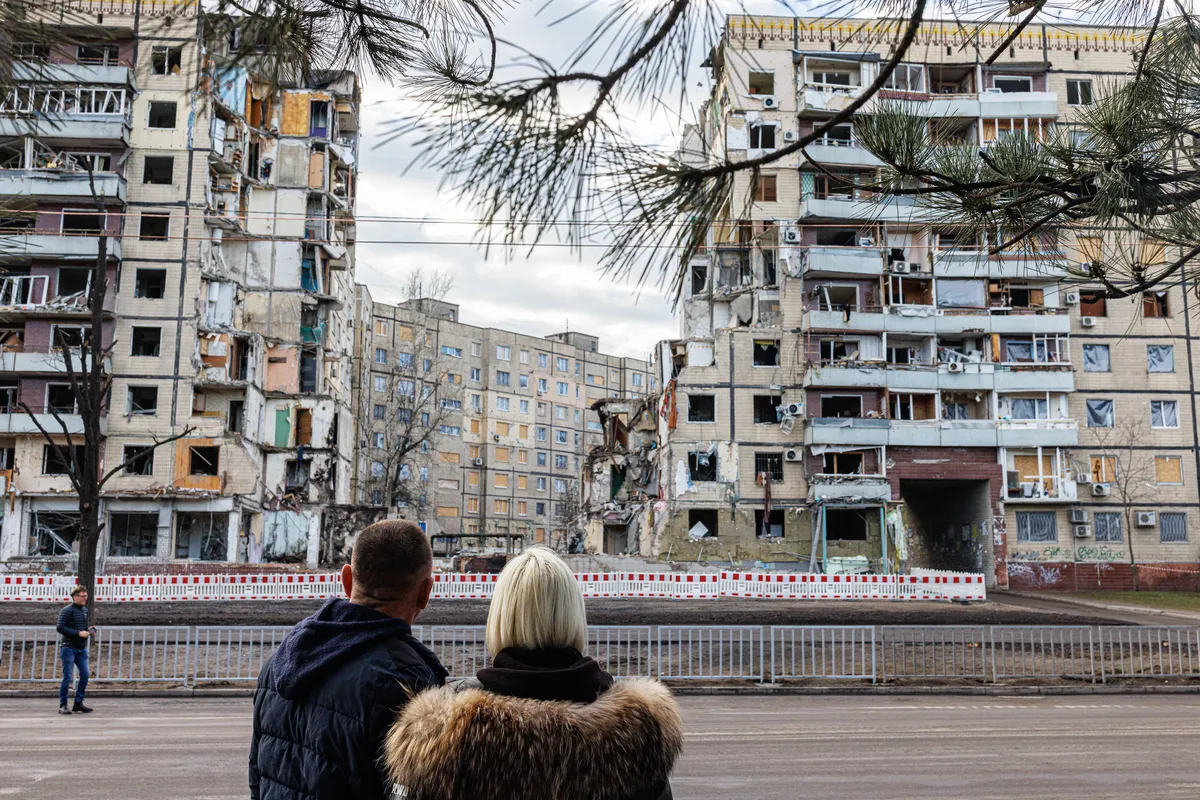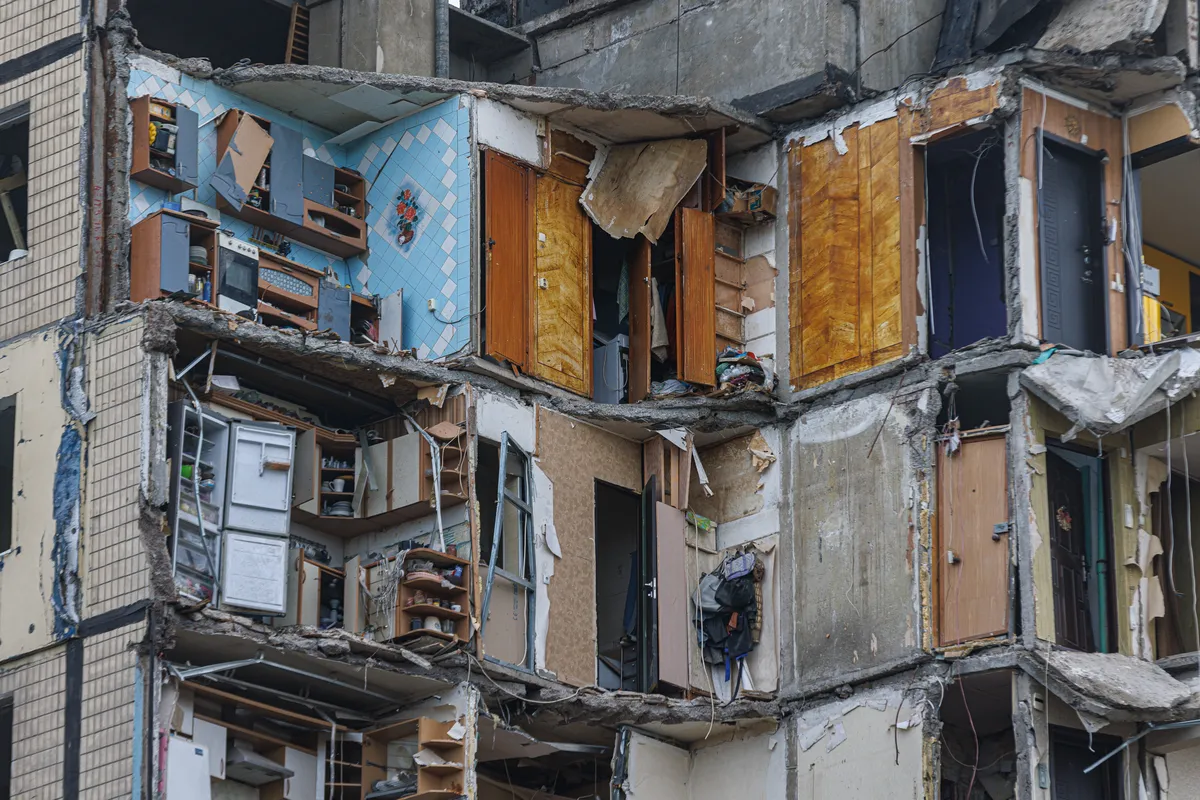
Forty-six people died after a Russian Kh-22 missile hit an apartment complex in Dnipro, Ukraine, pictured on Jan. 19. ANTON SKYBA /THE GLOBE AND MAIL
As soon as Artem Starosiek heard that a Russian Kh-22 missile had slammed into an apartment block in his hometown of Dnipro, he immediately felt he knew who was behind it: Colonel Oleg Timoshyn and Russia’s 52nd Guards Bomber Aviation Regiment.
Mr. Starosiek, the founder and CEO of Molfar, an open-source intelligence firm based in Dnipro, was already zeroing in on Col. Timoshyn and the unit he commands for their alleged role in a June blast that saw two Kh-22 missiles destroy a shopping mall in the city of Kremenchuk, killing 21 people.
Mr. Starosiek was on the verge of publishing the identity of Col. Timoshyn, whom Molfar’s team of researchers had concluded was the one who ordered the Kremenchuk attack, when a missile struck the Dnipro apartment block on Jan. 14. At least 46 people were killed in the nine-storey building on Victory Embankment Street – just a few hundred metres from where Mr. Starosiek had once lived.
The team at Molfar immediately redoubled their efforts. Within 24 hours they concluded that the Dnipro strike was carried out by the same Russian unit they had already been investigating.
On Sunday, Molfar struck back at those they believe were responsible for the attack on their city by publishing the name and face of not only Col. Timoshyn but those of 43 others who allegedly had roles in the Dnipro and Kremenchuk attacks.
The two rocket strikes are similar in many ways. In both cases, it’s possible the intended target was a nearby piece of civilian infrastructure, which would align with Russia’s strategy in recent months of pummelling Ukraine’s electricity, water and heating systems in an effort to dent civilian morale. In both cases, a Kh-22 – an anti-ship missile by design with a targeting system that is far less reliable when flying over dense cities – caused mass civilian casualties.
Ukrainian investigators had already identified Tupolev Tu-22M3 bombers taking off from Shaykovka air base, in Russia’s western Kaluga region, as having launched the missiles in both attacks. Molfar’s team of three investigators started from there, then combed Russian media for information about how the Shaykovka base operated and who worked there.
Articles in the local press led them to the 52nd regiment. There were also photographs of some of its commanders – including Col. Timoshyn – receiving commendations for their missions.
“We found photos of them getting medals after Kremenchuk. The same brigade also worked in Syria,” Mr. Starosiek said, referring to Russia’s intervention in the 12-year-old Syrian civil war, where Russian warplanes helped save the regime of dictator Bashar al-Assad from likely defeat.
Using the dozen or so names and photos they found in Russian coverage of the wars in Syria and Ukraine, the Molfar team then turned to social media for links to others who worked at Shaykovka. They came up with 44 names they believe played roles in the Kremenchuk and Dnipro attacks, including Colonel Andrey Samoylov, the commander of a Tu-22M3 crew. Others on the list range from commanders and pilots to maintenance and refuelling crews.

A memorial for the victims has been erected near the site of the attack. ANTON SKYBA /THE GLOBE AND MAIL
Now Molfar has put their names, photographs, service records and personal information – including, in some cases, their home addresses and names of known relatives – on its website.
“They’re all guilty. They all helped in this process,” Mr. Starosiek said Thursday, as rescue teams finally gave up all hope of finding survivors inside the ruins of the apartment building on Victory Embankment Street. “From my point of view every Russian – every Russian paying taxes to the government – is guilty in this war.”
But Mr. Starosiek directs most of his anger at Col. Timoshyn. “He gave the order, 100 per cent,” Mr. Starosiek said.
The Russian Ministry of Defence did not reply to e-mailed questions from The Globe and Mail regarding Molfar’s allegations.
Mr. Starosiek said Molfar first handed its evidence to Ukraine’s Security Service in the hope the information could be used either in a future war crimes trial or, more immediately, to help Ukraine’s military strike back directly at the alleged perpetrators. Ukrainian President Volodymyr Zelensky vowed after the Dnipro attack that “everyone involved in this terror” would be found and would pay a price. “Everyone will bear responsibility. Utmost responsibility.”
Before the war, Molfar conducted market research on behalf of companies trying to learn more about their competition, as well as background checks on individuals.
The company was part of an emerging high-tech scene in Dnipro, an industrial city with a prewar population of a million. Dnipro’s current population is difficult to estimate, as many residents have fled for Western Ukraine or Europe, but hundreds of thousands of others have arrived from cities closer to the front line or areas under Russian occupation.
The mood in the city was sombre this week as work on Victory Embankment Street shifted from a rescue effort to a clean-up operation, though forensic experts continue to look for human remains in the rubble. Because of the intensity of the fire caused by the missile strike, it has so far been impossible to identify 11 of the dead.
As an excavator picked concrete chunks off the ruins of the apartment block, residents continued to add to a giant pile of flowers at a bus stop across the street that has become a makeshift memorial.
“Our colleague lived here,” said Nikita Chernenko, a 22-year-old waiter who came with friends to lay a bouquet at the bus stop Thursday. “The rescue operation has stopped, but some people are still missing.”
MARK MACKINNON
SENIOR INTERNATIONAL CORRESPONDENT
The Globe and Mail, January 21, 2023

